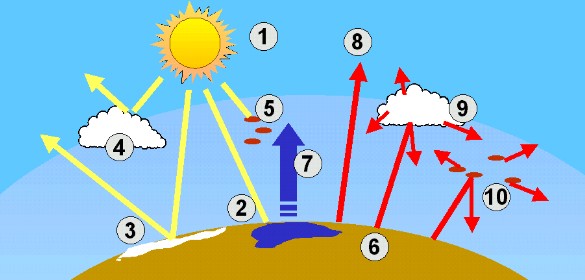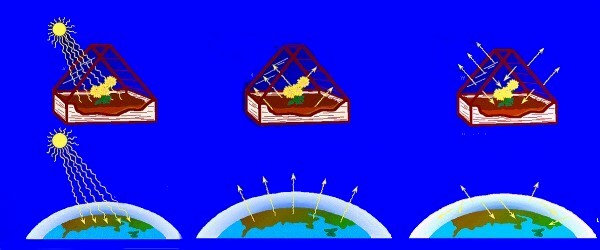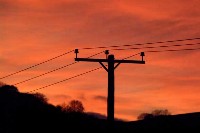 > ENC Master > Climate Encyclopaedia > Lower Atmosphere > basics > 2. Greenhouse, light & biosphere > - Greenhouse effect & light
> ENC Master > Climate Encyclopaedia > Lower Atmosphere > basics > 2. Greenhouse, light & biosphere > - Greenhouse effect & light
 |
|
|
|
Lower AtmosphereBasics |
Light and the Greenhouse effectWhat ever powers our planet, it comes from the sun. But what does happen to the light from the sun on its way to Earth and to the energy on its way back to the space?
|
The atmosphere has an influence on lightAs we learned in the first unit of this topic, the air consists of gases. There are also some particles floating in the air and there is a lot of water vapour in it, sometimes forming little droplets, which end up in clouds. During a dust storm, when the sun is pale or on a rainy day, when clouds cover the sky, it is much darker than on a bright day without any clouds and clear air. We can already imagine, that the amount of light reaching the Earth varies. However, not only clouds, but also the invisible gases of the air have an influence on the light coming from the sun.
|
|
Energy is balancedWhen sunlight reaches the Earth with its different landscapes, they become warmer. The water in the sea becomes warmer in summer, the streets even can become that hot, that it would be too warm to walk bare-footed. Since the Earth cannot store this heat forever, it sends energy back to the space. The radiation emitted from the Earth is another radiation than the one from the sun. The sunlight is visible (VIS) and ultraviolett light (UV). The energy coming back from the Earth is not visible, we call it infrared light (IR) or 'longwave radiation' or also heat radiation. It is less energetic than the sunlight.
If the Earth would not send back to the space all the energy coming from the sun, more and more energy would accumulate on the Earth and it would become hotter and hotter. But this is not the case. Energy is balanced. This means: the Earth gives back again what it has received.
|
 |
|
2. What happens to the radiation? We show it in ten points.
|
What happens, when radiation passes through the atmosphere?Let us first have a look what happens to the sunlight. (1) The sun is the source of all radiation and energy coming to the Earth from the space. The portion of the sunlight reaching the Earth warms up its surface. The Earth sends this warmth back as infrared radiation. Let us now have a look at what happens to this heat radiation. (6) The Earth's surface warmed up by the sun is a source of heat radiation (long wave infrared radiation) All this interaction of light with the atmosphere and the surface happens in our climate system and we have to take them into account, in order to understand the climate. But why do we call it a greenhouse effect?
|
 |
|
3. The greenhouse effect - comparing a greenhouse and the Earth!
|
|
The role of greenhouse gases in the atmosphere can be compared to the glass of a greenhouse: The glass lets the sunlight in, and the light warms the soil and plants in the greenhouse. These send out heat radiation, but when this heat radiation hits the glass, it doesn't pass through like the sunlight, but is absorbed and re-emitted by the glass. (Note, that glass is solid and also a barrier in the convection of warm air, so the comparison is not perfect.) This is in some way what greenhouse gases in the atmosphere do: They let the sunlight in, but they don't let the heat radiation from Earth out again.
|
About this page:Author: Dr. Elmar Uherek - Max Planck Institute for Chemistry, Mainz/Germany
|

